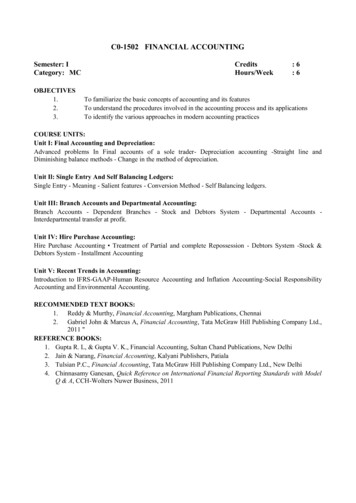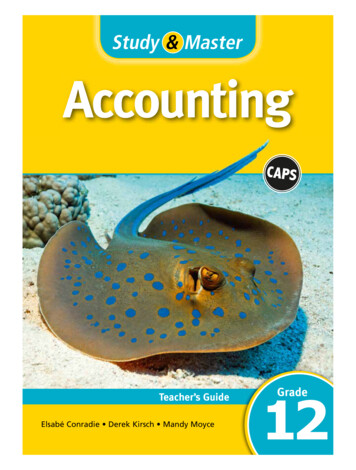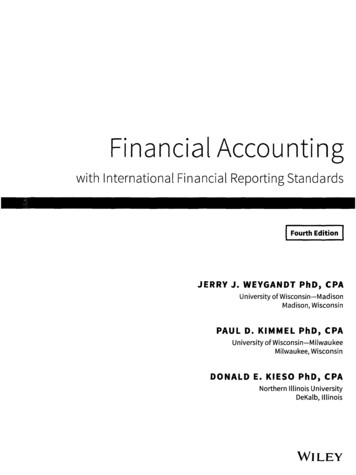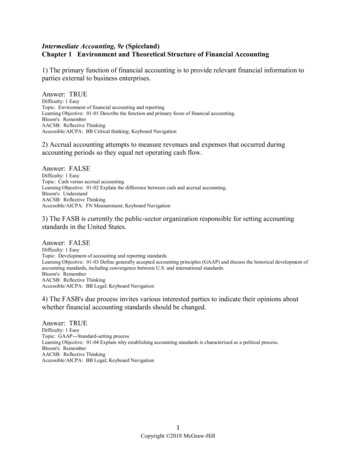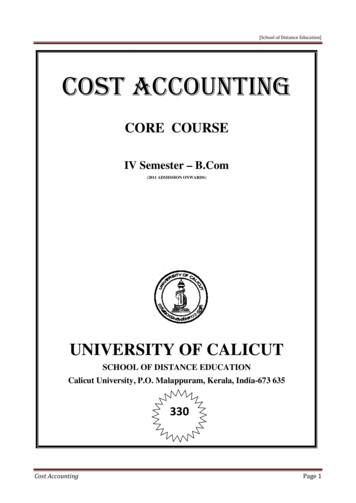
Transcription
Financial AccountingFifth EditionRobert KempUniversity of VirginiaJeffrey WaybrightSpokane Community CollegeNew York, NYA01 KEMP7790 05 SE FM.indd 112/9/17 1:49 AM
Vice President, Business, Economics, and UK Courseware: Donna BattistaDirector of Portfolio Management: Adrienne D’AmbrosioSenior Portfolio Manager: Lacey VitettaEditorial Assistant: Elisa MarksVice President, Product Marketing: Roxanne McCarleySenior Product Marketer: Tricia MurphyProduct Marketing Assistant: Marianela SilvestriManager of Field Marketing, Business Publishing: Adam GoldsteinField Marketing Manager: Nayke PopovichVice President, Production and Digital Studio, Arts and Business: Etain O’DeaDirector of Production, Business: Jeff HolcombManaging Producer, Business: Melissa FeimerContent Producer: Emily ThroneOperations Specialist: Carol MelvilleDesign Lead: Kathryn FootManager, Learning Tools: Brian SuretteContent Developer, Learning Tools: Sarah PetersonManaging Producer, Digital Studio and GLP, Media Production and Development: Ashley SantoraManaging Producer, Digital Studio and GLP: James BatemanManaging Producer, Digital Studio: Diane LombardoDigital Studio Producer: Mary Kate MurrayDigital Studio Producer: Alana ColesDigital Content Team Lead: Noel LotzDigital Content Project Lead: Martha LaChanceProject Manager: Thomas Murphy, SPi GlobalInterior Design: SPi GlobalCover Design: SPi GlobalCover Art: Greens87/Getty ImagesPrinter/Binder: LSC Communications, Inc./Courier KendallvilleCover Printer: Phoenix Color/HagerstownCopyright 2019, 2017, 2015 by Pearson Education, Inc. or its affiliates. All Rights Reserved. Manufactured in the United States of America. This publicationis protected by copyright, and permission should be obtained from the publisher prior to any prohibited reproduction, storage in a retrieval system, or transmission in any form or by any means, electronic, mechanical, photocopying, recording, or otherwise. For information regarding permissions, request forms, and theappropriate contacts within the Pearson Education Global Rights and Permissions department, please visit www.pearsoned.com/permissions/.Acknowledgments of third-party content appear on page xxvii, which constitutes an extension of this copyright page.PEARSON, ALWAYS LEARNING, and MYLAB are exclusive trademarks owned by Pearson Education, Inc. or its affiliates in the U.S. and/or other countries.Unless otherwise indicated herein, any third-party trademarks, logos, or icons that may appear in this work are the property of their respective owners, and anyreferences to third-party trademarks, logos, icons, or other trade dress are for demonstrative or descriptive purposes only. Such references are not intended toimply any sponsorship, endorsement, authorization, or promotion of Pearson’s products by the owners of such marks, or any relationship between the owner andPearson Education, Inc., or its affiliates, authors, licensees, or distributors.Cataloging-in-Publication Data is available on file at the Library of Congress.ISBN 10: 0-13-472779-7ISBN 13: 978-0-13-472779-0A01 KEMP7790 05 SE FM.indd 212/9/17 1:49 AM
The authors and Pearson Education, Inc. wish to thank Susan and Brian Miller,owners of Bold City Brewery, for their contributions to this edition of FinancialAccounting. They and their team have helped us make accounting come alivefor students by showing the importance of financial accounting in making anybusiness a success.A01 KEMP7790 05 SE FM.indd 312/9/17 1:49 AM
DedicationI dedicate this book to my beloved children: Adam, Meg, and Sarah.I also dedicate this book to their spouses and children. They givemeaning to my life, and are my dream come true.Robert KempI dedicate this edition to my wife, Lynne (aka Buttercup). You are sucha special gift to me.Jeffrey WaybrightA01 KEMP7790 05 SE FM.indd 412/9/17 1:49 AM
About the AuthorsRobert Kemp, DBA, CPA, is the Ramon W. Breeden, Sr., Research Professor at the McIntire School of Commerce in the University of Virginia. He is a certified public accountantand possesses baccalaureate, master’s, and doctorate degrees in business administration.Professor Kemp is an accomplished scholar who conducts research and writing in thetheory and practice of contemporary business. He currently is conducting research in thefunding of pensions, the management of financial institutions, and corporate finance.His scholarly works include 70 completed projects, including monographs, articles, cases,research presentations, and working papers. His work is published in, among other places,The Financial Review; The Journal of Financial Research; Advances in Accounting, AResearch Journal; Benefits Quarterly; The Journal of Mathematics Applied in Businessand Industry; The Journal of Accountancy; The Journal of Commercial Bank Lending;The Journal of Bank Accounting and Auditing; and The Journal of Business Economics.Professor Kemp is an accomplished teacher to university students and executivesthroughout the world. During his 36 years at the University of Virginia, he has taughtnumerous undergraduate and graduate courses using lectures, case studies, discussiongroups, and distance learning. His consistently high evaluations by students reflect hisdevotion to the classroom. This high quality is also seen in his teaching of businessexecutives. He has worked with and taught for organizations such as Bank of America,the FDIC, Navigant—Tucker Alan, the Siberian Banking Institute, the Barents Group,KPMG, Gerson Lehrman, Wellington Management, the Russian Bankers Association,the Central Asian American Enterprise Fund, the American Institute of Certified PublicAccountants, and the Consumer Bankers Association.Jeffrey Waybright teaches accounting at Spokane Community College, which is part ofa multi-college district in eastern Washington. He has been a full-time, tenured, community college instructor for more than 25 years, and has also taught upper division coursesfor Linfield College. He is a co-recipient of the Washington Society of CPA’s OutstandingEducator Award.Mr. Waybright received his bachelor of arts degree in business administration (with anemphasis in accounting) and master’s of arts degree from Eastern Washington University.Before becoming a professor, he spent eight years as a practicing CPA in Washington state,and still holds his license. During his teaching career, he has taught many disciplines ofaccounting, including financial, managerial, computerized, and payroll accounting, as wellas the disciplines of entrepreneurship, economics, business math, and general business.Mr. Waybright developed online courses in accounting, teaches online and traditionalcourses for financial and managerial accounting, and advises students. He is passionateabout teaching students the subject of accounting.vA01 KEMP7790 05 SE FM.indd 512/9/17 1:49 AM
A01 KEMP7790 05 SE FM.indd 612/9/17 1:49 AM
Brief ContentsChapter 1Business, Accounting, and YouChapter 2Analyzing and Recording Business TransactionsChapter 3Adjusting and Closing Entries101Chapter 4Accounting for a Merchandising Business159Chapter 5Inventory212Chapter 6The Challenges of Accounting: Standards, Internal Control, Audits, Fraud, and Ethics260Chapter 7Cash and Receivables293Chapter 8Long-Term and Other Assets355Chapter 9Current Liabilities and Long-Term Debt406Chapter 10Corporations: Paid-In Capital and Retained Earnings454Chapter 11The Statement of Cash Flows504Chapter 12Financial Statement Analysis564Appendix AColumbia Sportswear Company Annual Report 2016 to Shareholders621Appendix BTime Value of Money—Future and Present Value Concepts697Appendix CFASB Update—Revenue Recognition705Company Index707Glindex715Credits731151viiA01 KEMP7790 05 SE FM.indd 712/9/17 1:49 AM
A01 KEMP7790 05 SE FM.indd 812/9/17 1:49 AM
ContentsChapter 1Business, Accounting, and YouBusiness, Accounting, and You 1What Is a Business, and Why Study Accounting? 2The Definition of a Business 2The General Concept of Value 3Business Owners and Other Stakeholders 4The Goal of a Business 4How Does a Business Operate? 5Accounting, Business, and You—Putting It All Together 241SUMMARY 24ACCOUNTING PRACTICE 27APPLY YOUR KNOWLEDGE 47KNOW YOUR BUSINESS 47Chapter 2Analyzing and Recording BusinessTransactionsResources Needed to Start and Operate a Business 5Business, Accounting, and You 51Operating a Business 5How Are Accounts Used to Keep Business Transactions Organized? 52The Cost of Money 6How Are Businesses Organized? 6Organizing Accounts 52Types of Businesses 6Assets 52Legal Forms of Businesses 7Liabilities 53What Is Accounting, and What Are the Key Accounting Principles and Concepts? 9Generally Accepted Accounting Principles 9International Financial Reporting Standards 9The Business Entity Principle 10The Reliability (Objectivity) Principle 10The Cost Principle 10Accounting Ethics: A Matter of Trust 10What Is the Role of Accounting in a Business? 11How Do You Recognize a Business Transaction? 11Cash Accounting 11Accrual Accounting 12How Do You Measure a Business Transaction? 12How Do You Record Business Transactions Using the Accounting Equation? 12Transaction Analysis 13Stockholders’ Equity 13How Do You Report Business Transactions UsingFinancial Statements? 18Stockholders’ Equity 53What Is Double-Entry Accounting? 54Normal Balance 55How Are the General Journal and General LedgerUsed to Keep Track of Business Transactions? 56Transaction Analysis 57Applying Transaction Analysis 57Balancing the T-Accounts 65How Is a Trial Balance Prepared, and What Is ItUsed For? 67Correcting Errors 67Preparation of Financial Statements 68SUMMARY 72ACCOUNTING PRACTICE 73APPLY YOUR KNOWLEDGE 97KNOW YOUR BUSINESS 98Chapter 3The Income Statement 19Adjusting and Closing EntriesThe Statement of Retained Earnings 19Business, Accounting, and You 101The Balance Sheet 19The Statement of Cash Flows 21Relationships Among the Financial Statements 2151101How Does a Company Accurately Report Its Income? 102Revenue Recognition and Matching Principles 102ixA01 KEMP7790 05 SE FM.indd 912/9/17 1:49 AM
xContentsWhat Is the Role of Adjusting Entries, and When Are TheyPrepared? 104How Do You Prepare a Merchandiser’s FinancialStatements? 176Accruing Revenues 105The Income Statement 176Accruing Expenses 106Statement of Retained Earnings 179Adjusting Deferred Revenues 107Balance Sheet 179Adjusting Deferred Expenses 108SUMMARY 183How Are Financial Statements Prepared from an AdjustedTrial Balance? 113The Adjusted Trial Balance 113ACCOUNTING PRACTICE 186APPLY YOUR KNOWLEDGE 209KNOW YOUR BUSINESS 209Preparing the Financial Statements 115How Does a Company Prepare for a New AccountingPeriod? 117Chapter 5InventoryCompleting the Accounting Cycle 117Three Closing Entries: Revenues, Expenses, and Dividends 118Business, Accounting, and You 212Post-Closing Trial Balance 120What Inventory Costing Methods Are Allowed? 213Summary of the Adjusting and Closing Processes 120Cost Flow versus Physical Flow of Inventory 214How Are the Four Inventory Costing Methods Applied? 216SUMMARY 123ACCOUNTING PRACTICE 125Inventory Cost Flows 216APPLY YOUR KNOWLEDGE 154Specific Identification Method 217KNOW YOUR BUSINESS 154First-In, First-Out (FIFO) Method 217COMPREHENSIVE PROBLEM 157Last-In, First-Out (LIFO) Method 219Average Cost Method 220Chapter 4Accounting for a Merchandising Business212Journalizing Inventory Transactions 221159What Effect Do the Different Costing Methods Have on NetIncome? 222Business, Accounting, and You 159What Else Determines How Inventory Is Valued? 224What Are the Relationships Among Manufacturers, Wholesalers, Retailers, and Customers? 160How Is Inventory Reported on a Balance Sheet? 225How Do Periodic and Perpetual Inventory SystemsDiffer? 160How Do Inventory Errors Affect Financial Statements? 226How Do You Account for the Purchase of Inventory? 161Cash and Credit Purchases 161Purchase Discounts 162Purchase Returns and Allowances 164How Do You Account for the Sale of Inventory? 165Cash Sales 165Inventory Shrinkage 226Is It Possible to Estimate the Value of Inventory If the InventoryIs Accidentally Destroyed? 228SUMMARY 231ACCOUNTING PRACTICE 233APPLY YOUR KNOWLEDGE 255KNOW YOUR BUSINESS 256COMPREHENSIVE PROBLEM 258Credit Sales 166Sales Discounts 167Sales Returns and Allowances 168Adjusting Entry to Record Estimated Returns and Allowances 169Sales Returns 169Sales Allowances 170How Do You Account for Freight Charges and Other SellingExpenses? 171Chapter 6The Challenges of Accounting: Standards, Internal Control, Audits,Fraud, and Ethics260Business, Accounting, and You 260What Are the Rules That Govern Accounting? 261Costs Related to the Receipt of Goods from Suppliers 172Understandable 261Costs Related to Delivering Goods to Customers 174Relevant 261Other Selling Costs 175Reliable 261A01 KEMP7790 05 SE FM.indd 1012/9/17 1:49 AM
ContentsGenerally Accepted Accounting Principles (GAAP) in theUnited States 262How Are Accounts Receivable Reported on the BalanceSheet? 311Generally Accepted Accounting Principles Around theWorld: IFRS 263How Do You Account for Notes Receivable? 311Identifying the Maturity Date 312Differences Between FASB and IFRS 263Origination of Notes Receivable 313What Is Internal Control? 265Computing Interest on a Note 313Elements of an Internal Control System 265Accruing Interest Revenue 314What Is Fraud, and Who Commits It? 268SUMMARY 318Management Fraud 268ACCOUNTING PRACTICE 320Employee Embezzlement 269APPLY YOUR KNOWLEDGE 346Factors Usually Present When Fraud Is Committed 269KNOW YOUR BUSINESS 347What Is a Certified Public Accountant (CPA)? 271Appendix 7A 349Audits 271What Is a Petty Cash Fund? 349External Auditor Responsibilities 272Setting Up a Petty Cash Fund 349What Are the Legal and Ethical Responsibilitiesof Accountants? 274Replenishing the Petty Cash Fund 350Legal Responsibilities of Accountants 274Changing the Petty Cash Fund 351Ethical Responsibilities of Accountants 275ACCOUNTING PRACTICE 352SUMMARY 278Chapter 8ACCOUNTING PRACTICE 280APPLY YOUR KNOWLEDGE 287Long-Term and Other AssetsKNOW YOUR BUSINESS 290Business, Accounting, and You 355293How Is the Cost of a Fixed Asset Calculated? 356Land and Land Improvements 357Business, Accounting, and You 293Buildings 358What Internal Control Procedures Should Be Usedfor Cash? 294Machinery and Equipment 358Furniture and Fixtures 359Internal Controls over Cash Receipts 294Lump-Sum (Basket) Purchase of Assets 359Internal Control over Cash Payments 295How Are Fixed Assets Depreciated? 360Purchase and Payment Processes 295Measuring Depreciation 361The Bank Reconciliation 296Depreciation Methods 362Preparing a Bank Reconciliation 297Comparing Depreciation Methods 365Online Banking 302Partial-Year Depreciation 366How Is Cash Reported on a Balance Sheet? 303Changing the Useful Life of a Depreciable Asset 367How Do You Account for Receivables? 303Using Fully Depreciated Assets 368Types of Receivables 303How Are Costs of Repairing Fixed Assets Recorded? 369Internal Control over Accounts Receivable 304Ordinary Repairs 369Accounting for Uncollectible Accounts Receivable 304Extraordinary Repairs 369How Do You Account for Uncollectible Accounts? 304Betterments 369The Direct Write-Off Method 304What Happens When a Fixed Asset Is Disposed? 370Direct Write-Off Method: Recovering Accounts Previously Written Off 305How Do You Account for Intangible Assets? 373The Allowance Method 305Specific Intangibles 373Estimating the Amount of Uncollectible Accounts 306Accounting for Research and Development Costs 375Writing Off Uncollectible Accounts Under the Allowance Method 309How Are Natural Resources Accounted For? 375Allowance Method: Recovering Accounts Previously Written Off 310What Are Other Assets? 376A01 KEMP7790 05 SE FM.indd 11355What Are the Different Types of Long-Term Assets? 356Chapter 7Cash and Receivablesxi12/9/17 1:49 AM
xiiContentsHow Are Long-Term Assets Reported on the Balance Sheet? 377Dividend Dates 460SUMMARY 380Declaring and Paying Dividends 461ACCOUNTING PRACTICE 382Dividing Dividends between Preferred and Common Shareholders 462APPLY YOUR KNOWLEDGE 402Dividends on Cumulative and Noncumulative Preferred Stock 463KNOW YOUR BUSINESS 403How Are Stock Dividends and Stock Splits AccountedFor? 464Chapter 9Current Liabilities andLong-Term DebtHow Are Cash Dividends Accounted For? 460Stock Dividends 464406Recording Stock Dividends 465Stock Splits 467Business, Accounting, and You 406What Are the Differences Among Known, Estimated, and Contingent Liabilities? 407Stock Dividends and Stock Splits Compared 469How Is Treasury Stock Accounted For? 469Treasury Stock Basics 469How Do You Account for Current Liabilities of aKnown Amount? 407Purchase of Treasury Stock 470Sale of Treasury Stock 470Accounts Payable 407Sales Tax Payable 409How Is Stockholders’ Equity Reported on the BalanceSheet? 473Accrued Expenses (Accrued Liabilities) 410SUMMARY 475Unearned Revenues 410ACCOUNTING PRACTICE 477Current Portion of Long-Term Debt 410APPLY YOUR KNOWLEDGE 501Notes Payable 408How Do You Account for Current Liabilities of anUncertain Amount? 411KNOW YOUR BUSINESS 502Estimated Warranty Liability 411Chapter 11Estimated Refund Liability 412How Do You Account for a Contingent Liability? 412The Statement of Cash FlowsHow Do You Account for Long-Term Debt? 413Business, Accounting, and You 504Notes Payable 413504What Is the Statement of Cash Flows? 505Bonds Payable 415How Does a Business Create a Statement of Cash Flows? 507Lease Liabilities 422How Are Liabilities Reported on the Balance Sheet? 423The Logic of How the Statement of Cash Flows Is Prepared 507SUMMARY 427Sources and Uses of Cash: Categorizing Changes as Operating, Investing,or Financing 508ACCOUNTING PRACTICE 429Statement of Cash Flows: Two Formats 510APPLY YOUR KNOWLEDGE 450How Is the Statement of Cash Flows Prepared Using the Indirect Method? 511KNOW YOUR BUSINESS 451Cash Flows from Operating Activities 513Chapter 10Corporations: Paid-In Capital andRetained EarningsCash Flows from Investing Activities 515454Business, Accounting, and You 454How Are Corporations Organized? 455What Makes Up the Stockholders’ Equity of a Corporation? 456Stockholders’ Rights 456Cash Flows from Financing Activities 517Net Change in Cash and Cash Balances 519Noncash Investing and Financing Activities 519How Is the Statement of Cash Flows Prepared Using theDirect Method? 522Cash Flows from Operating Activities 523Classes of Stock 457SUMMARY 529Par Value, Stated Value, and No-Par Stock 457ACCOUNTING PRACTICE 531How Is the Issuance of Stock Recorded? 458APPLY YOUR KNOWLEDGE 558Issuing Common Stock 458KNOW YOUR BUSINESS 559Issuing Preferred Stock 460COMPREHENSIVE PROBLEM 561A01 KEMP7790 05 SE FM.indd 1212/9/17 1:49 AM
ContentsChapter 12Financial Statement Analysis564Business, Accounting, and You 564What Is Financial Analysis? 565Step One: Understand a Business’s Model and Strategy 565Step Two: Understand the Environment in Which the BusinessOperates 566Step Three: Analyze the Content of the Financial Statements and OtherInformation, Making Adjustments If Desired 567Step Four: Analyze the Business’s Operations 567Step Five: Use the Financial Analysis to Make Decisions 568What Measures Does Someone Use to Analyze the Performance of a Business? 568Financial Analysis Techniques 569Vertical Analysis 571Horizontal Analysis 572Trend Percentages 574Question One: Is the Business a Going Concern? 574An Example: Bold City Brewery, Inc. 575Question Two: How Is the Business Earning a Net Income or Loss? 576How Do You Put Everything Together to MakeDecisions? 585Seeing the Impact of Decisions 587What Are Red Flags in Financial Statement Analysis? 587SUMMARY 590ACCOUNTING PRACTICE 592APPLY YOUR KNOWLEDGE 617KNOW YOUR BUSINESS 618Appendix AColumbia Sportswear Company AnnualReport 2016 to Shareholders621Appendix BTime Value of Money—Future and Present Value ConceptsFuture-Value Tables 698Future Value of an Annuity 699Present Value 700Present-Value Tables 701Question Three: Where Is the Business Getting Its Money? Can It Pay ItsDebt Obligations? 579Present Value of an Annuity 701Question Four: How Is the Business Investing Its Money? Is It Using ItsAssets Efficiently? 580An Example: Bold City Brewery, Inc. 581Question Five: Is the Business Generating Enough Net Income to Rewardthe Stockholders for the Use of Their Money? 582An Example: Bold City Brewery, Inc. 583A01 KEMP7790 05 SE FM.indd 13697Future Value 697An Example: Bold City Brewery, Inc. 578An Example: Bold City Brewery, Inc. 579xiiiACCOUNTING PRACTICE 703Appendix CFASB Update—Revenue Recognition 705Company Index 707Glindex 715Credits 73112/9/17 1:49 AM
A01 KEMP7790 05 SE FM.indd 1412/9/17 1:49 AM
PrefaceChanges to This EditionChapter 1Business, Accounting, and You Expanded the use of Bold City Brewery, a real-life successful entrepreneurial venture,to demonstrate the use and importance of accounting. Updated the “Try It!” problem. Updated the examples used in “How They Do It: A Look at Business.” Updated the Continuing Financial Statement Analysis Problem featuring Dick’sSporting Goods using the 2016 annual report. Updated end-of-chapter material related to Columbia Sportswear and UnderArmour using the 2016 annual reports.Chapter 2Analyzing and Recording Business Transactions Expanded the use of Bold City Brewery, a real-life successful entrepreneurial venture,to demonstrate the use and importance of accounting. Updated the “Try It!” problem. Updated the examples used in “How They Do It: A Look at Business.” Updated the Continuing Financial Statement Analysis Problem featuring Dick’sSporting Goods using the 2016 annual report. Updated end-of-chapter material related to Columbia Sportswear and UnderArmour using the 2016 annual reports.Chapter 3Adjusting and Closing Entries Expanded the use of Bold City Brewery, a real-life successful entrepreneurial venture,to demonstrate the use and importance of accounting. Updated the “Try It!” problem. Updated the examples used in “How They Do It: A Look at Business.” Updated the Continuing Financial Statement Analysis Problem featuring Dick’sSporting Goods using the 2016 annual report. Updated end-of-chapter material related to Columbia Sportswear and UnderArmour using the 2016 annual reports.Chapter 4Accounting for a Merchandising Business Fully integrated the new revenue recognition standard in text, exercises andproblems. Expanded the use of Bold City Brewery, a real-life successful entrepreneurial venture,to demonstrate the use and importance of accounting. Updated the “Try It!” problem.xvA01 KEMP7790 05 SE FM.indd 1512/9/17 1:49 AM
xviPreface Updated the examples used in “How They Do It: A Look at Business.” Updated the Continuing Financial Statement Analysis Problem featuring Dick’sSporting Goods using the 2016 annual report. Updated end-of-chapter material related to Columbia Sportswear and UnderArmour using the 2016 annual reports.Chapter 5Inventory Expanded the use of Bold City Brewery, a real-life successful entrepreneurial venture,to demonstrate the use and importance of accounting. Updated the “Try It!” problem. Updated the examples used in “How They Do It: A Look at Business.” Updated the Continuing Financial Statement Analysis Problem featuring Dick’sSporting Goods using the 2016 annual report. Updated end-of-chapter material related to Columbia Sportswear and UnderArmour using the 2016 annual reports.Chapter 6 The Challenges of Accounting: Standards, InternalControl, Audits, Fraud, and Ethics Expanded the use of Bold City Brewery, a real-life successful entrepreneurial venture,to demonstrate the use and importance of accounting. Updated the auditor’s responsibilities with regard to auditing internal controls. Updated the “Try It!” problem. Updated the examples used in “How They Do It: A Look at Business.” Updated the Continuing Financial Statement Analysis Problem featuring Dick’sSporting Goods using the 2016 annual report. Updated end-of-chapter material related to Columbia Sportswear and UnderArmour using the 2016 annual reports.Chapter 7Cash and Receivables Expanded the use of Bold City Brewery, a real-life successful entrepreneurial venture,to demonstrate the use and importance of accounting. Updated the “Try It!” problem. Updated the examples used in “How They Do It: A Look at Business.” Updated the Continuing Financial Statement Analysis Problem featuring Dick’sSporting Goods using the 2016 annual report. Updated end-of-chapter material related to Columbia Sportswear and UnderArmour using the 2016 annual reports.Chapter 8Long-Term and Other Assets Expanded the use of Bold City Brewery, a real-life successful entrepreneurial venture,to demonstrate the use and importance of accounting. Updated the “Try It!” problem. Updated the examples used in “How They Do It: A Look at Business.” Updated the Continuing Financial Statement Analysis Problem featuring Dick’sSporting Goods using the 2016 annual report. Updated end-of-chapter material related to Columbia Sportswear and UnderArmour using the 2016 annual reports.A01 KEMP7790 05 SE FM.indd 1612/9/17 1:49 AM
PrefaceChapter 9xviiCurrent Liabilities and Long-Term Debt Expanded the use of Bold City Brewery, a real-life successful entrepreneurial venture,to demonstrate the use and importance of accounting. Updated the “Try It!” problem. Updated the examples used in “How They Do It: A Look at Business.” Updated the Continuing Financial Statement Analysis Problem featuring Dick’sSporting Goods using the 2016 annual report. Updated end-of-chapter material related to Columbia Sportswear and UnderArmour using the 2016 annual reports.Chapter 10Corporations: Paid-In Capital and Retained Earnings Expanded the use of Bold City Brewery, a real-life successful entrepreneurial venture,to demonstrate the use and importance of accounting. Updated the “Try It!” problem. Updated the examples used in “How They Do It: A Look at Business.” Updated the Continuing Financial Statement Analysis Problem featuring Dick’sSporting Goods using the 2016 annual report. Updated end-of-chapter material related to Columbia Sportswear and UnderArmour using the 2016 annual reports.Chapter 11The Statement of Cash Flows Expanded the use of Bold City Brewery, a real-life successful entrepreneurial venture,to demonstrate the use and importance of accounting. Updated the “Try It!” problem. Updated the examples used in “How They Do It: A Look at Business.” Updated the Continuing Financial Statement Analysis Problem featuring Dick’sSporting Goods using the 2016 annual report. Updated end-of-chapter material related to Columbia Sportswear and UnderArmour using the 2016 annual reports.Chapter 12Financial Statement Analysis Expanded the use of the Bold City Brewery, a real-life successful entrepreneurial venture, to demonstrate the use and importance of accounting. Updated the “Try It!” problem. Updated the examples used in “How They Do It: A Look at Business.” Updated the Continuing Financial Statement Analysis Problem featuring Dick’sSporting Goods using the 2016 annual report. Updated end-of-chapter material related to Columbia Sportswear and UnderArmour using the 2016 annual reports.A01 KEMP7790 05 SE FM.indd 1712/9/17 1:49 AM
Solving Teaching and Learning ChallengesDear Colleagues,We are very excited about the newest edition of Kemp and Waybright’s Financial Accounting. Afteryou have had a chance to look at this edition’s changes, we think you will be as excited about our latestedition as we are.Practical Approach: Accounting from a Business PerspectiveAs has been our goal in past editions, the fifth edition of Financial Accounting is all about helping students learn. We believe the text and supporting materials tackle challenging topics in a pragmatic, easilyunderstood manner so that students understand not only accounting but its critical role in the businessworld. We want to help you help your students master the basic concepts of financial accounting andapply them to everyday business decisions.To help with this goal, we’ve focused the fifth edition on businesses to which students can better relate.First, we use Bold City Brewery—a successful, entrepreneurial business—to introduce, develop, anddemonstrate the topic of each chapter. We conclude each chapter by showing the importance of thechapter topic to Bold City Brewery and larger firms. Second, throughout the chapter and at the endof the chapter, we use examples and problems that reflect typical businesses that students encounter intheir real lives. This means smaller and more manageable numbers.Execution: Ensuring Student SuccessEvery feature in Financial Accounting is about helping you, the faculty, help your students achieve thisgoal. Based on our years of teaching, we believe we have created a complete package of instructionalmaterials using traditional and digital methods. For example, examine how each topic is introduced,explained, and demonstrated. Notice how students not only learn the topic, but also see how it is appliedin the real world. Moreover, the end-of-chapter exercises, problems, and cases, all prepared by us, createa progressive and appropriately challenging learning experience. Included in this edition are more than18 live examples so students can test their understanding of the relationship between the general journal,journal entries, and the impact on the accounting equation. These materials were all crafted carefully tohelp you ensure your students have more of those “I get it” moments.Assessment: Ensuring Your SuccessWe are first and foremost teachers. It’s our passion. We understand the challenges you face as teachers. For example, to assure continuity between the text and the assessments, we prepared the solutionsmanual and contributed to the algorithmic test bank, which we also checked for accuracy. In additionto these supplements, there are automatically graded homewor
accounting, including financial, managerial, computerized, and payroll accounting, as well as the disciplines of entrepreneurship, economics, business math, and general business. Mr. Waybright developed online courses in accounting, teaches online and traditional courses for financial and managerial

